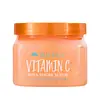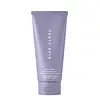What's inside
What's inside
 Key Ingredients
Key Ingredients

 Benefits
Benefits

 Concerns
Concerns

 Ingredients Side-by-side
Ingredients Side-by-side

Sucrose
HumectantGlycerin
HumectantPolysorbate 20
EmulsifyingSilica
AbrasiveAloe Barbadensis Leaf Juice
Skin ConditioningCitrus Paradisi Peel Oil
MaskingCocos Nucifera Shell Powder
AbrasiveButyrospermum Parkii Butter
Skin ConditioningOenothera Biennis Oil
EmollientCitrus Aurantium Dulcis Peel Oil
MaskingMacadamia Ternifolia Seed Oil
EmollientPrunus Amygdalus Dulcis Oil
Skin ConditioningCarthamus Tinctorius Seed Oil
MaskingPersea Gratissima Oil
Skin ConditioningRetinyl Palmitate
Skin ConditioningAscorbic Acid
AntioxidantLactic Acid
BufferingWater
Skin ConditioningParfum
MaskingSorbic Acid
PreservativePhenoxyethanol
PreservativeCaprylyl Glycol
EmollientCI 14700
Cosmetic ColorantCI 15510
Cosmetic ColorantSucrose, Glycerin, Polysorbate 20, Silica, Aloe Barbadensis Leaf Juice, Citrus Paradisi Peel Oil, Cocos Nucifera Shell Powder, Butyrospermum Parkii Butter, Oenothera Biennis Oil, Citrus Aurantium Dulcis Peel Oil, Macadamia Ternifolia Seed Oil, Prunus Amygdalus Dulcis Oil, Carthamus Tinctorius Seed Oil, Persea Gratissima Oil, Retinyl Palmitate, Ascorbic Acid, Lactic Acid, Water, Parfum, Sorbic Acid, Phenoxyethanol, Caprylyl Glycol, CI 14700, CI 15510
Sucrose
HumectantGlycine Soja Oil
EmollientHelianthus Annuus Seed Oil
EmollientSea Salt
AbrasiveCocos Nucifera Oil
MaskingButyrospermum Parkii Butter
Skin ConditioningPolyglyceryl-3 Caprate
EmulsifyingSilica
AbrasiveCaprylic/Capric Triglyceride
MaskingTrihydroxystearin
Skin ConditioningStyrene/Butadiene Copolymer
Persea Gratissima Fruit Powder
AbrasiveLactobacillus/Punica Granatum Fruit Ferment Extract
Skin ConditioningPapain
Skin ConditioningBromelain
Skin ConditioningQuartz
AbrasiveTocopherol
AntioxidantCitric Acid
BufferingPumice
AbrasiveCaprylyl Glycol
EmollientMaltodextrin
AbsorbentPhenoxyethanol
PreservativePentaerythrityl Tetra-Di-T-Butyl Hydroxyhydrocinnamate
AntioxidantParfum
MaskingHydroxycitronellal
PerfumingLimonene
PerfumingSucrose, Glycine Soja Oil, Helianthus Annuus Seed Oil, Sea Salt, Cocos Nucifera Oil, Butyrospermum Parkii Butter, Polyglyceryl-3 Caprate, Silica, Caprylic/Capric Triglyceride, Trihydroxystearin, Styrene/Butadiene Copolymer, Persea Gratissima Fruit Powder, Lactobacillus/Punica Granatum Fruit Ferment Extract, Papain, Bromelain, Quartz, Tocopherol, Citric Acid, Pumice, Caprylyl Glycol, Maltodextrin, Phenoxyethanol, Pentaerythrityl Tetra-Di-T-Butyl Hydroxyhydrocinnamate, Parfum, Hydroxycitronellal, Limonene
 Reviews
Reviews

Ingredients Explained
These ingredients are found in both products.
Ingredients higher up in an ingredient list are typically present in a larger amount.
This ingredient is also known as shea butter. It is an effective skin hydrator and emollient.
Emollients help soothe and soften your skin. It does this by creating a protective film on your skin. This barrier helps trap moisture and keeps your skin hydrated. Emollients may be effective at treating dry or itchy skin.
Shea butter is rich in antioxidants. Antioxidants help fight free-radicals, or molecules that may harm the body. It is also full of fatty acids including stearic acid and linoleic acid. These acids help replenish the skin and keep skin moisturized.
While Shea Butter has an SPF rating of about 3-4, it is not a sunscreen replacement.
Shea butter may not be fungal acne safe. We recommend speaking with a professional if you have any concerns.
Learn more about Butyrospermum Parkii ButterCaprylyl Glycol is a humectant and emollient, meaning it attracts and preserves moisture.
It is a common ingredient in many products, especially those designed to hydrate skin. The primary benefits are retaining moisture, skin softening, and promoting a healthy skin barrier.
Though Caprylyl Glycol is an alcohol derived from fatty acids, it is not the kind that can dry out skin.
This ingredient is also used as a preservative to extend the life of products. It has slight antimicrobial properties.
Learn more about Caprylyl GlycolParfum is a catch-all term for an ingredient or more that is used to give a scent to products.
Also called "fragrance", this ingredient can be a blend of hundreds of chemicals or plant oils. This means every product with "fragrance" or "parfum" in the ingredients list is a different mixture.
For instance, Habanolide is a proprietary trade name for a specific aroma chemical. When used as a fragrance ingredient in cosmetics, most aroma chemicals fall under the broad labeling category of “FRAGRANCE” or “PARFUM” according to EU and US regulations.
The term 'parfum' or 'fragrance' is not regulated in many countries. In many cases, it is up to the brand to define this term.
For instance, many brands choose to label themselves as "fragrance-free" because they are not using synthetic fragrances. However, their products may still contain ingredients such as essential oils that are considered a fragrance by INCI standards.
One example is Calendula flower extract. Calendula is an essential oil that still imparts a scent or 'fragrance'.
Depending on the blend, the ingredients in the mixture can cause allergies and sensitivities on the skin. Some ingredients that are known EU allergens include linalool and citronellol.
Parfum can also be used to mask or cover an unpleasant scent.
The bottom line is: not all fragrances/parfum/ingredients are created equally. If you are worried about fragrances, we recommend taking a closer look at an ingredient. And of course, we always recommend speaking with a professional.
Learn more about ParfumPhenoxyethanol is a preservative that has germicide, antimicrobial, and aromatic properties. Studies show that phenoxyethanol can prevent microbial growth. By itself, it has a scent that is similar to that of a rose.
It's often used in formulations along with Caprylyl Glycol to preserve the shelf life of products.
Silica, also known as silicon dioxide, is a naturally occurring mineral. It is used as a fine, spherical, and porous powder in cosmetics.
Though it has exfoliant properties, the function of silica varies depending on the product.
The unique structure of silica enhances the spreadability and adds smoothness, making it a great texture enhancer.
It is also used as an active carrier, emulsifier, and mattifier due to its ability to absorb excess oil.
In some products, tiny microneedles called spicules are made from silica or hydrolyzed sponge. When you rub them in, they lightly polish away dead skin layers and enhance the penetration of active ingredients.
Learn more about SilicaSucrose is a natural sugar found in fruits, vegetables, and nuts. It is the main constituent of white sugar.
In skincare, sucrose is a humectant and can be a mild exfoliant.
Sucrose is hydrophilic, meaning it attracts water. This makes it an effective humectant and helps hydrate the skin.
Studies show sugars may worsen acne-prone skin due to it disrupting the skin's natural biome. We recommend speaking with a professional if you have any concerns.
In some products such as body scrubs, sucrose is used as an gentle exfoliant.
The term 'sucrose' comes from the french word for sugar, 'sucre'.
Learn more about Sucrose